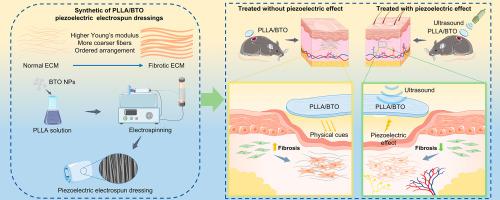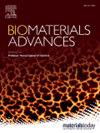Piezoelectric nanocomposite electrospun dressings: Tailoring mechanics for scar-free wound recovery
IF 6
2区 医学
Q2 MATERIALS SCIENCE, BIOMATERIALS
Materials Science & Engineering C-Materials for Biological Applications
Pub Date : 2024-11-13
DOI:10.1016/j.bioadv.2024.214119
引用次数: 0
Abstract
Rational wound management and enhancing healing quality are critical in clinical practice. Electrical stimulation therapy (EST) has emerged as a valuable adjunctive treatment due to its safety and cost-effectiveness. Integrating piezoelectric materials into dressings offers a way to miniaturize and personalize electrotherapy, enhancing convenience. To address the impact of physical factors of dressings on wound healing, a nanocomposite piezoelectric electrospun dressing using poly(L-lactic acid) (PLLA) and barium titanate (BaTiO3) was developed. We intentionally exaggerated design flaws to mimic the characteristics of scar extracellular matrix (ECM), including the oriented thick fibers and high Young's modulus. Initially, these dressings promoted fibrosis and hindered functional regeneration. However, when the piezoelectric effect was triggered by ultrasound, the fibrotic phenotype was reversed, leading to scar-free healing with well-regenerated functional structures. This study highlights the significant therapeutic potential of piezoelectric dressings in skin wound treatment and underscores the importance of carefully designing the static physical properties of dressings for optimal efficacy.

压电纳米复合电纺敷料:无疤痕伤口恢复的定制力学
在临床实践中,合理的伤口管理和提高愈合质量至关重要。电刺激疗法(EST)以其安全性和成本效益成为一种重要的辅助治疗方法。将压电材料集成到敷料中可实现电疗的微型化和个性化,从而提高治疗的便利性。为了解决敷料的物理因素对伤口愈合的影响,我们开发了一种使用聚乳酸(PLLA)和钛酸钡(BaTiO3)的纳米复合压电电纺敷料。我们有意夸大了设计缺陷,以模仿疤痕细胞外基质(ECM)的特征,包括取向粗纤维和高杨氏模量。起初,这些敷料会促进纤维化,阻碍功能再生。然而,当超声波触发压电效应时,纤维化表型被逆转,导致无疤痕愈合和功能结构的良好再生。这项研究凸显了压电敷料在皮肤伤口治疗中的巨大治疗潜力,并强调了精心设计敷料的静态物理特性以获得最佳疗效的重要性。
本文章由计算机程序翻译,如有差异,请以英文原文为准。
求助全文
约1分钟内获得全文
求助全文
来源期刊
CiteScore
17.80
自引率
0.00%
发文量
501
审稿时长
27 days
期刊介绍:
Biomaterials Advances, previously known as Materials Science and Engineering: C-Materials for Biological Applications (P-ISSN: 0928-4931, E-ISSN: 1873-0191). Includes topics at the interface of the biomedical sciences and materials engineering. These topics include:
• Bioinspired and biomimetic materials for medical applications
• Materials of biological origin for medical applications
• Materials for "active" medical applications
• Self-assembling and self-healing materials for medical applications
• "Smart" (i.e., stimulus-response) materials for medical applications
• Ceramic, metallic, polymeric, and composite materials for medical applications
• Materials for in vivo sensing
• Materials for in vivo imaging
• Materials for delivery of pharmacologic agents and vaccines
• Novel approaches for characterizing and modeling materials for medical applications
Manuscripts on biological topics without a materials science component, or manuscripts on materials science without biological applications, will not be considered for publication in Materials Science and Engineering C. New submissions are first assessed for language, scope and originality (plagiarism check) and can be desk rejected before review if they need English language improvements, are out of scope or present excessive duplication with published sources.
Biomaterials Advances sits within Elsevier''s biomaterials science portfolio alongside Biomaterials, Materials Today Bio and Biomaterials and Biosystems. As part of the broader Materials Today family, Biomaterials Advances offers authors rigorous peer review, rapid decisions, and high visibility. We look forward to receiving your submissions!

 求助内容:
求助内容: 应助结果提醒方式:
应助结果提醒方式:


